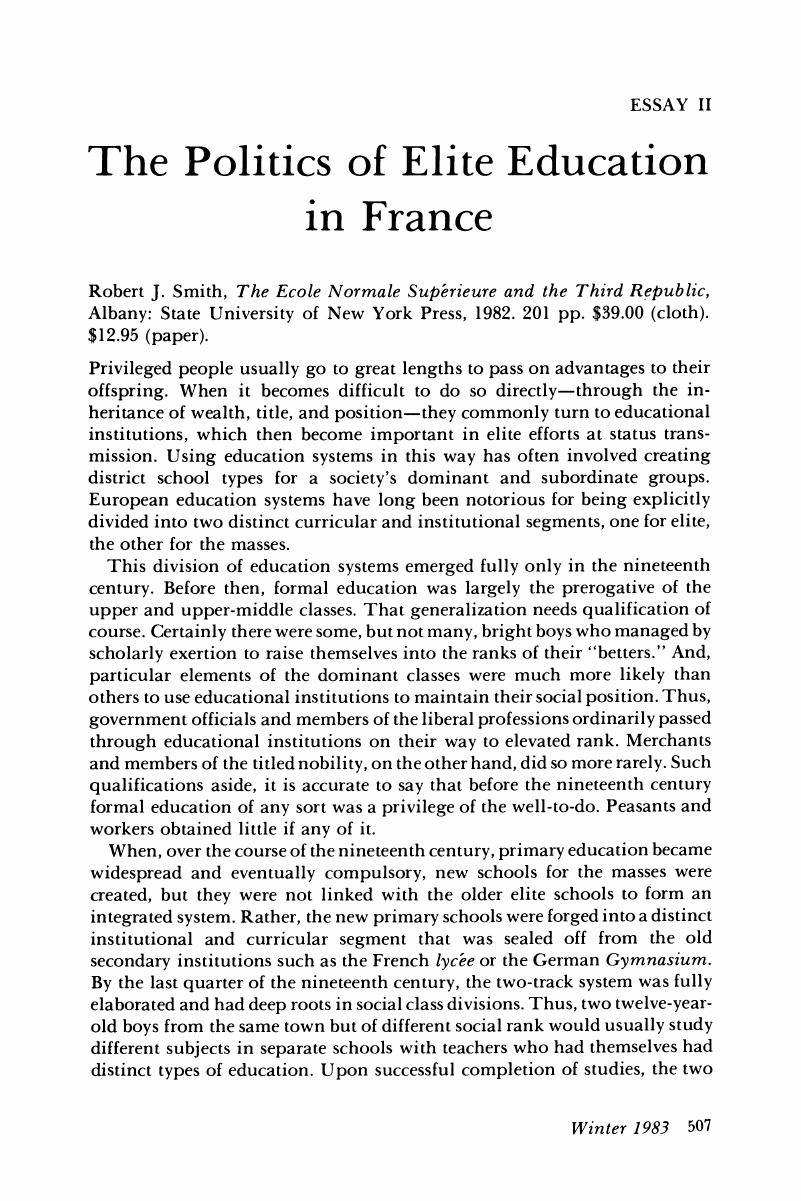No CrossRef data available.
Article contents
The Politics of Elite Education in France - Robert J. Smith, The Ecole Normale Supérieure and the Third Republic, Albany: State University of New York Press, 1982. 201 pp. $39.00 (cloth). $12.95 (paper).
Published online by Cambridge University Press: 24 February 2017
Abstract

- Type
- Essay Review II
- Information
- Copyright
- Copyright © 1983 by History of Education Society
References
Notes
1. The two most informative recent studies of the Ecole Polytechnique are Shinn, Terry, Savior Scientifique et Pouvoir Social: L'Ecole Polytechnique, 1794–1914 (Paris, 1980) and Sulieman, Ezra N., Elites in French Society: the Politics of Survival (Princeton, 1978).Google Scholar
2. Important discussions of this aspect of Normale's character can be found in Ringer, Fritz K., Education and Society in Modern Europe (Bloomington, Indiana, 1979) and Karady, Victor, “Normaliens et autres enseignants á la Belle Epoque: Note sur l'origine sociale et la réussite dans une profession intellectuelle,” Revue francaise de Sociologie, 13 (1972): 35–58.Google Scholar
3. Bourdieu, Pierre, “Epreuve scolaire et consécration sociale: les classes préparatoires aux grandes écoles,” Actes de la Recherche en Sciences Sociales, No. 39 (Sept., 1981): 1–70.Google Scholar
4. That term and the principles of analysis in this paragraph are borrowed from Ringer, , Education and Society in Modern Europe. Of course, since the number of potentially relevant background characteristics is indefinitely numerous, the choice of which ones to study (race, sex, parental income, ethnicity, geographical origins, father's occupation, etc. will depend to some extent on a prior theoretical determination of which among them are most important. The issue is further complicated by the fact that every individual will of necessity have many such background characteristics. Today, controversies over educational opportunity often hinge on such factors. Has a graduate school progressed if it has significantly raised the percentage of women it admits if, in so doing, it also raises the socio-economic status of its students? Or, does it count as progress if an institution recruits more males of working-class origin, even if they are exclusively white?.Google Scholar
5. Figures drawn from or calculated on the basis of Smith's Table 4, p. 34. The opportunity ratio for workers appears to have improved somewhat. For Smith's group of students, it was about 0.13 for skilled and unskilled workers taken together. In the preparatory classes for the grandes écoles in the academic year 1980–81, it was about 0.25 (Bourdieu, , “Epreuve scolaire et consécration sociale:” 64), which is to say, the chances of a worker sending his son to a grande ecole have moved from very, very bad to very bad.Google Scholar
6. For an account of the rural isolation of much of France that persisted well into the twentieth century see Weber, Eugen, Peasants into Frenchmen: the Modernization of Rural France, 1870–1914 (Stanford 1976).Google Scholar
7. A striking example of the persistence of cultural patterns can be obtained by comparing Smith's account of the geographic distribution of normaliens with the sales of the Enlightenment's most representative cultural work, Diderot's Encyclopédie, as described in Darnton, Robert, The Business of Enlightenment: A Publishing History of the Encyclopédie, 1775–1880 (Cambridge, Massachusetts, 1979). The same towns that bought many Encyclopédies in the late eighteenth century sent many of their sons to Normale in the late nineteenth, and vice versa.Google Scholar


